Flow Velocity and Sand Loading Effect on Erosion–Corrosion during Liquid-Solid Impingement on Mild Steel
Abstract
:1. Introduction
2. Materials and Methods
2.1. Sand Particles
2.2. Sample
2.3. Solutions
2.4. Experimental Setup and Test Conditions
3. Results and Discussions
3.1. Effect of Time on
3.2. Effect of Static Corrosion on Weight Loss
3.3. Effect of Velocity and Sand Loading
3.4. Empirical Regression Model That Relates the and with the Velocity and Sand Loading
4. Conclusions
Author Contributions
Funding
Institutional Review Board Statement
Informed Consent Statement
Data Availability Statement
Conflicts of Interest
References
- Heitz, E. Mechanistically based prevention strategies of flow-induced corrosion. Electrochim. Acta 1996, 41, 503–509. [Google Scholar] [CrossRef]
- Neville, A.; Hu, X. Mechanical and electrochemical interactions during liquid–solid impingement on high-alloy stainless steels. Wear 2001, 251, 1284–1294. [Google Scholar] [CrossRef]
- Neville, A.; Hodgkiess, T. Characterisation of high-grade alloy behaviour in severe erosion–corrosion conditions. Wear 1999, 233–235, 596–607. [Google Scholar] [CrossRef]
- Yang, Y.; Cheng, Y. Parametric effects on the erosion–corrosion rate and mechanism of carbon steel pipes in oil sands slurry. Wear 2012, 276–277, 141–148. [Google Scholar] [CrossRef]
- Owen, J.; Ramsey, C.; Barker, R.; Neville, A. Erosion-corrosion interactions of X65 carbon steel in aqueous CO2 environments. Wear 2018, 414–415, 376–389. [Google Scholar] [CrossRef]
- Neville, A.; Hodgkiess, T.; Dallas, J. A study of the erosion-corrosion behaviour of engineering steels for marine pumping applications. Wear 1995, 186–187, 497–507. [Google Scholar] [CrossRef]
- Souza, V.; Neville, A. Corrosion and synergy in a WCCoCr HVOF thermal spray coating—Understanding their role in erosion–corrosion degradation. Wear 2005, 259, 171–180. [Google Scholar] [CrossRef]
- Elemuren, R.; Evitts, R.; Oguocha, I.; Kennell, G.; Gerspacher, R.; Odeshi, A. Slurry erosion-corrosion of 90° AISI 1018 steel elbow in saturated potash brine containing abrasive silica particles. Wear 2018, 410–411, 149–155. [Google Scholar] [CrossRef]
- Lu, B.T.; Luo, J.L. Synergism of Electrochemical and Mechanical Factors in Erosion−Corrosion. J. Phys. Chem. B 2006, 110, 4217–4231. [Google Scholar] [CrossRef]
- Bateni, M.R.; Szpunar, J.; Wang, X.; Li, D. Wear and corrosion wear of medium carbon steel and 304 stainless steel. Wear 2006, 260, 116–122. [Google Scholar] [CrossRef]
- Guo, H.; Lu, B.; Luo, J. Interaction of mechanical and electrochemical factors in erosion–corrosion of carbon steel. Electrochimica Acta 2005, 51, 315–323. [Google Scholar] [CrossRef]
- Postlethwaite, J.; Dobbin, M.H.; Bergevin, K. The Role of Oxygen Mass Transfer in the Erosion-Corrosion of Slurry Pipelines. Corrosion 1986, 42, 514–521. [Google Scholar] [CrossRef]
- Neville, A.; Reyes, M.; Xu, H. Examining corrosion effects and corrosion/erosion interactions on metallic materials in aqueous slurries. Tribol. Int. 2002, 35, 643–650. [Google Scholar] [CrossRef]
- Abedini, M.; Ghasemi, H. Synergistic erosion–corrosion behavior of Al–brass alloy at various impingement angles. Wear 2014, 319, 49–55. [Google Scholar] [CrossRef]
- Burstein, G.T.; Sasaki, K. Effect of impact angle on the slurry erosion-corrosion of 304L stainless steel. Wear 2000, 240, 80–94. [Google Scholar] [CrossRef]
- Clark, H.M. Particle velocity and size effects in laboratory slurry erosion measurements OR… do you know what your particles are doing? Tribol. Int. 2002, 35, 617–624. [Google Scholar] [CrossRef]
- Karafyllias, G.; Galloway, A.; Humphries, E. The effect of low pH in erosion-corrosion resistance of high chromium cast irons and stainless steels. Wear 2019, 420–421, 79–86. [Google Scholar] [CrossRef]
- Jellesen, M.S.; Christiansen, T.L.; Hilbert, L.R.; Møller, P. Erosion–corrosion and corrosion properties of DLC coated low temperature gas-nitrided austenitic stainless steel. Wear 2009, 267, 1709–1714. [Google Scholar] [CrossRef]
- Hussain, E.; Robinson, M. Erosion–corrosion of 2205 duplex stainless steel in flowing seawater containing sand particles. Corros. Sci. 2007, 49, 1737–1754. [Google Scholar] [CrossRef]
- Mohammadi, F.; Luo, J. Effects of particle angular velocity and friction force on erosion enhanced corrosion of 304 stainless steel. Corros. Sci. 2010, 52, 2994–3001. [Google Scholar] [CrossRef]
- Zhou, G.; Ding, H.; Zhang, Y.; Li, N. Corrosion–erosion wear behaviors of 13Cr24Mn0. 44N stainless steel in saline–sand slurry. Tribol. Int. 2010, 43, 891–896. [Google Scholar]
- Lu, B.; Mao, L.; Luo, J. Hydrodynamic effects on erosion-enhanced corrosion of stainless steel in aqueous slurries. Electrochim. Acta 2010, 56, 85–92. [Google Scholar] [CrossRef]
- López, D.; Falleiros, N.A.; Tschiptschin, A.P. Corrosion–erosion behaviour of austenitic and martensitic high nitrogen stainless steels. Wear 2007, 263, 347–354. [Google Scholar] [CrossRef]
- Aribo, S.; Barker, R.; Hu, X.; Neville, A. Erosion–corrosion behaviour of lean duplex stainless steels in 3.5% NaCl solution. Wear 2012, 302, 1602–1608. [Google Scholar] [CrossRef]
- Zhang, G.; Xu, L.; Cheng, Y. Investigation of erosion–corrosion of 3003 aluminum alloy in ethylene glycol–water solution by impingement jet system. Corros. Sci. 2009, 51, 283–290. [Google Scholar] [CrossRef]
- He, D.; Jiang, X.; Li, S.; Guan, H. Erosion and Erosion-Corrosion Behaviors of Several Stainless Steels in Dual-Phase Fluid. Corrosion 2002, 58, 276–282. [Google Scholar] [CrossRef]
- Vreeland, D.C. Corrosion-Erosion of Sensitized AISI Type 304 Stainless Steel in a Thorium Dioxide-Uranium Trioxide Slurry. Corrosion 1961, 17, 21t–24t. [Google Scholar] [CrossRef]
- Senatore, E.; Taleb, W.; Owen, J.; Hua, Y.; Gomes, J.A.P.; Barker, R.; Neville, A. Evaluation of high shear inhibitor performance in CO2-containing flow-induced corrosion and erosion-corrosion environments in the presence and absence of iron carbonate films. Wear 2018, 404–405, 143–152. [Google Scholar] [CrossRef] [Green Version]
- Barker, R.; Neville, A.; Hu, X.; Cushnaghan, S. Evaluating Inhibitor Performance in CO2-Saturated Erosion-Corrosion Environments. Corrosion 2015, 71, 14–29. [Google Scholar] [CrossRef]
- Hu, X.; Barker, R.; Neville, A.; Gnanavelu, A. Case study on erosion–corrosion degradation of pipework located on an offshore oil and gas facility. Wear 2011, 271, 1295–1301. [Google Scholar] [CrossRef]
- Hassani, S.; Roberts, K.P.; Shirazi, S.A.; Rybicki, E.F.; Shadley, J.R.; Joia, C.-J.B. A New Approach for Predicting Inhibited Erosion-Corrosion in CO2-Saturated Oil/Brine Flow Condition. All Days 2012, 28, 135–144. [Google Scholar] [CrossRef]
- Hu, X.; Neville, A. CO2 erosion–corrosion of pipeline steel (API X65) in oil and gas conditions—A systematic approach. Wear 2009, 267, 2027–2032. [Google Scholar] [CrossRef]
- Meng, H.; Hu, X.; Neville, A. A systematic erosion–corrosion study of two stainless steels in marine conditions via experimental design. Wear 2007, 263, 355–362. [Google Scholar] [CrossRef]
- Shehadeh, M.; Anany, M.; Saqr, K.M.; Hassan, I. Experimental investigation of erosion-corrosion phenomena in a steel fitting due to plain and slurry seawater flow. Int. J. Mech. Mater. Eng. 2014, 9, 1–8. [Google Scholar] [CrossRef] [Green Version]
- Harvey, T.J.; Wharton, J.A.; Wood, R.J.K. Development of synergy model for erosion–corrosion of carbon steel in a slurry pot. Tribol.-Mater. Surfaces Interfaces 2007, 1, 33–47. [Google Scholar] [CrossRef]
- De Waard, C.; Milliams, D.E. Carbonic Acid Corrosion of Steel. Corrosion 1975, 31, 177–181. [Google Scholar] [CrossRef]
- De Waard, C.; Lotz, U.; Milliams, D.E. Predictive Model for CO2 Corrosion Engineering in Wet Natural Gas Pipelines. Corrosion 1991, 47, 976–985. [Google Scholar] [CrossRef]
- De Waard, C.; Lotz, U. Corrosion 93; NACE: Huston, TX, USA, 1993. [Google Scholar]
- De Waard, C.; Lotz, U.; Dugstad, A. Corrosion’95; Paper No. 128; NACE International: Houston, TX, USA, 1995. [Google Scholar]
- Nesic, S.; Nordsveen, M.; Nyborg, R.; Stangeland, A. Corrosion’2001; Paper No. 40; NACE: Houston, TX, USA, 2001. [Google Scholar]
- Hodgkiess, T.; Neville, A.; Shrestha, S. Electrochemical and mechanical interactions during erosion–corrosion of a high-velocity oxy-fuel coating and a stainless steel. Wear 1999, 233–235, 623–634. [Google Scholar] [CrossRef]
- Parsi, M.; Najmi, K.; Najafifard, F.; Hassani, S.; McLaury, B.S.; Shirazi, S.A. A comprehensive review of solid particle erosion modeling for oil and gas wells and pipelines applications. J. Nat. Gas Sci. Eng. 2014, 21, 850–873. [Google Scholar] [CrossRef]
- Levy, A.V. Solid Particle Erosion and Erosion-Corrosion of Materials; ASM International: Phoenix, AZ, USA, 1995. [Google Scholar]
- Finnie, I. Erosion of surfaces by solid particles. Wear 1960, 3, 87–103. [Google Scholar] [CrossRef]
- Hutchings, I. Prediction of the resistance of metals to erosion by solid particles. Wear 1975, 35, 371–374. [Google Scholar] [CrossRef]
- Dhar, S.; Krajac, T.; Ciampini, D.; Papini, M. Erosion mechanisms due to impact of single angular particles. Wear 2005, 258, 567–579. [Google Scholar] [CrossRef]
- Desale, G.R.; Gandhi, B.K.; Jain, S. Slurry erosion of ductile materials under normal impact condition. Wear 2008, 264, 322–330. [Google Scholar] [CrossRef]
- Malka, R.; Nešić, S.; Gulino, D.A. Erosion–corrosion and synergistic effects in disturbed liquid-particle flow. Wear 2007, 262, 791–799. [Google Scholar] [CrossRef] [Green Version]
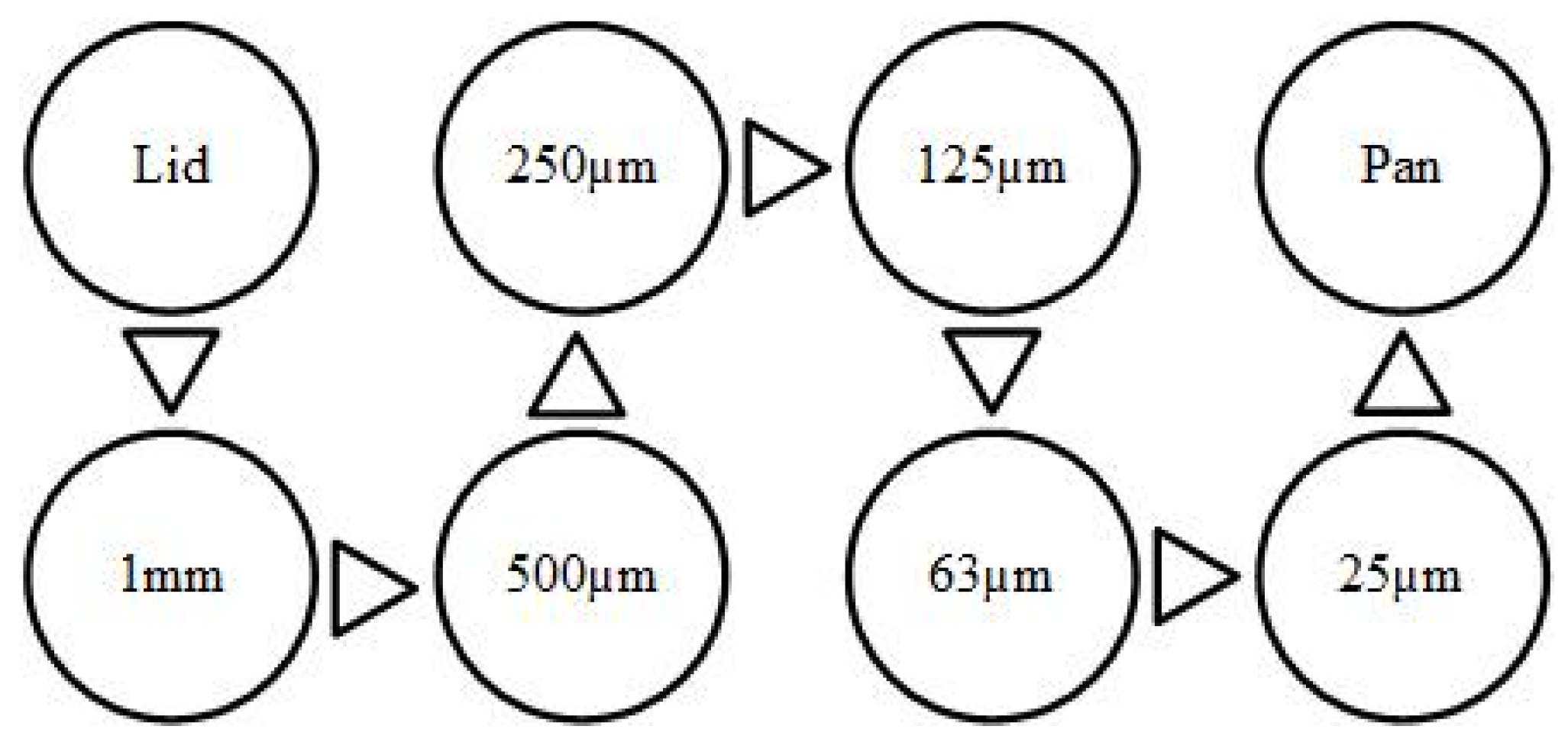
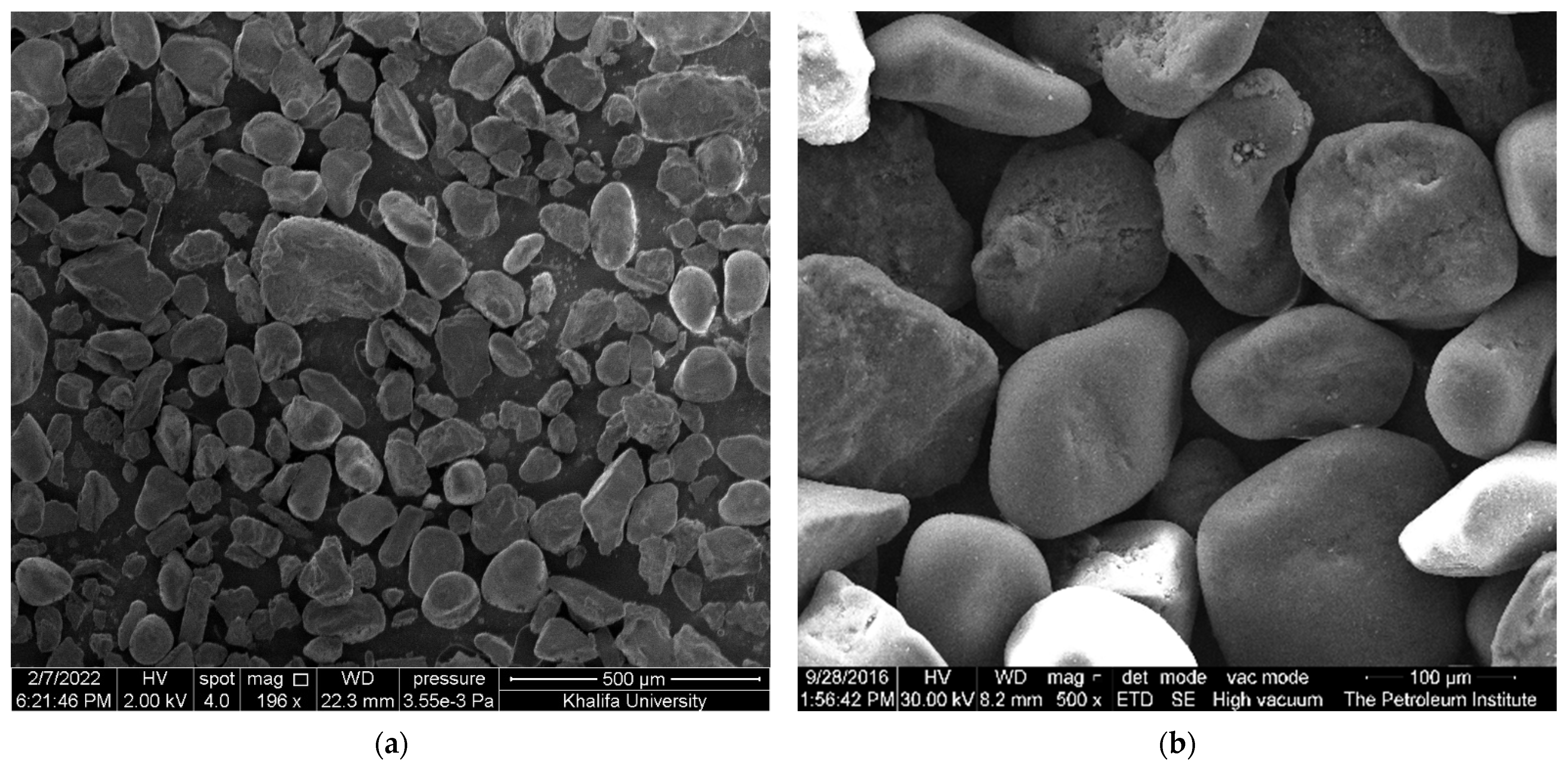
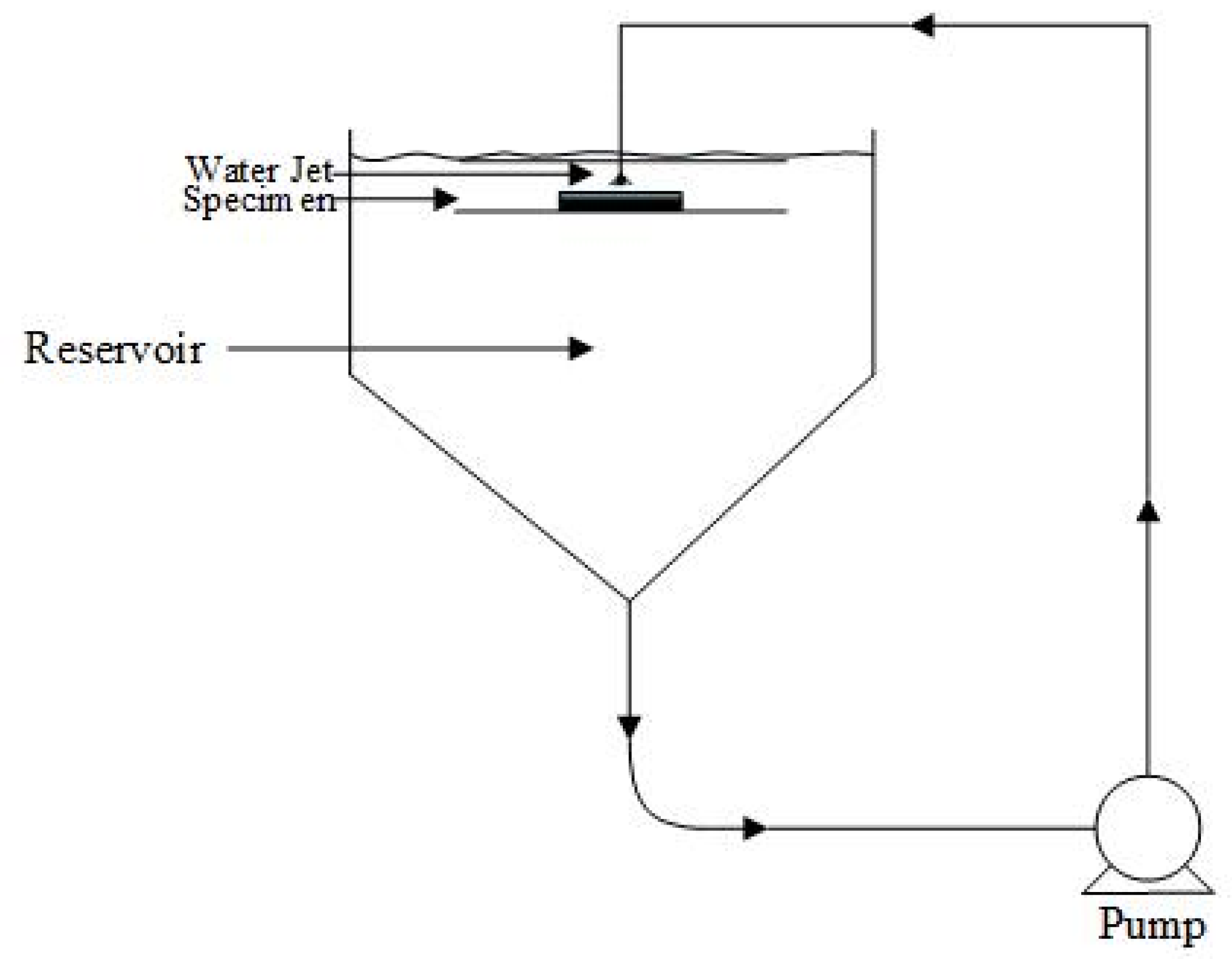
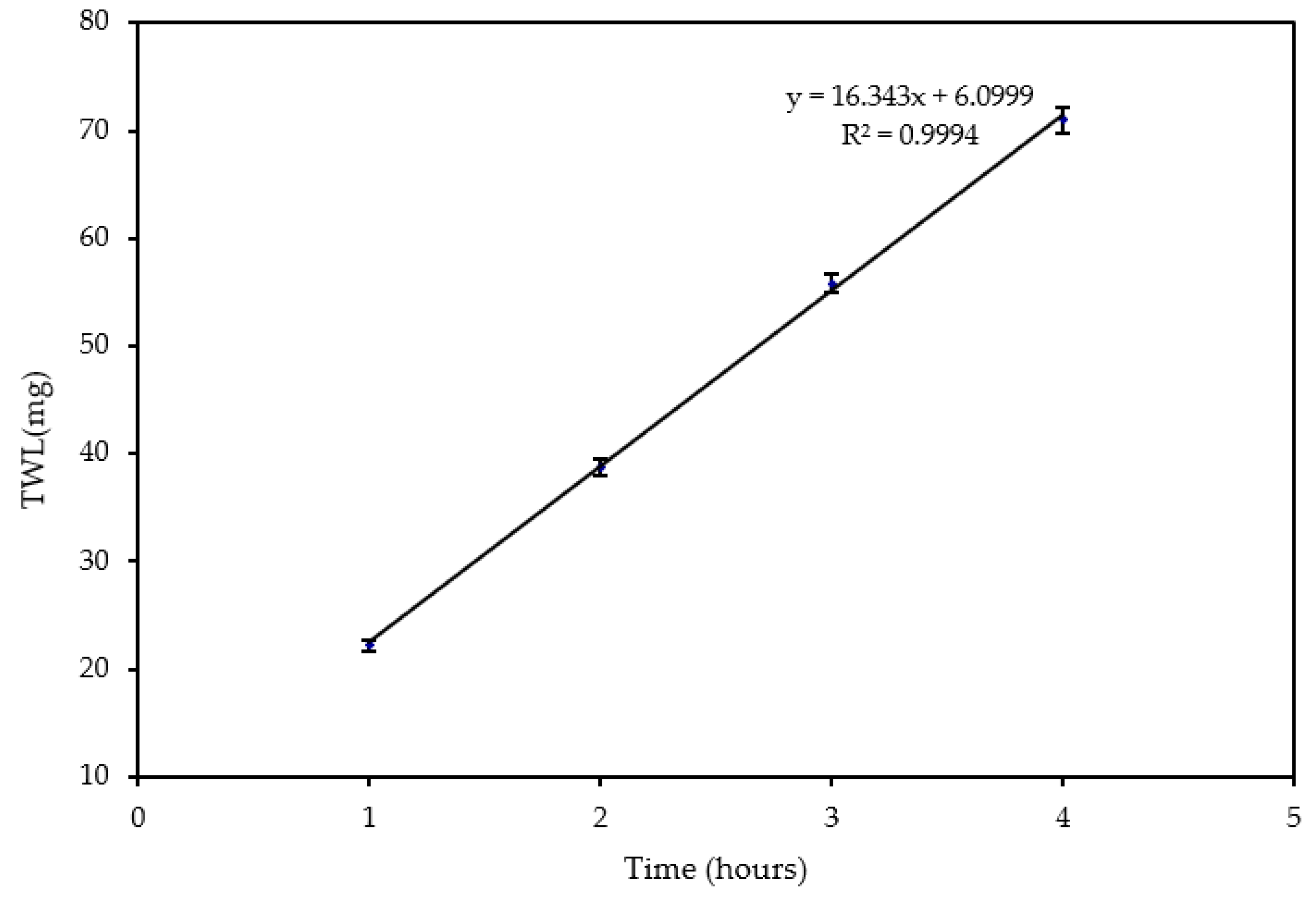
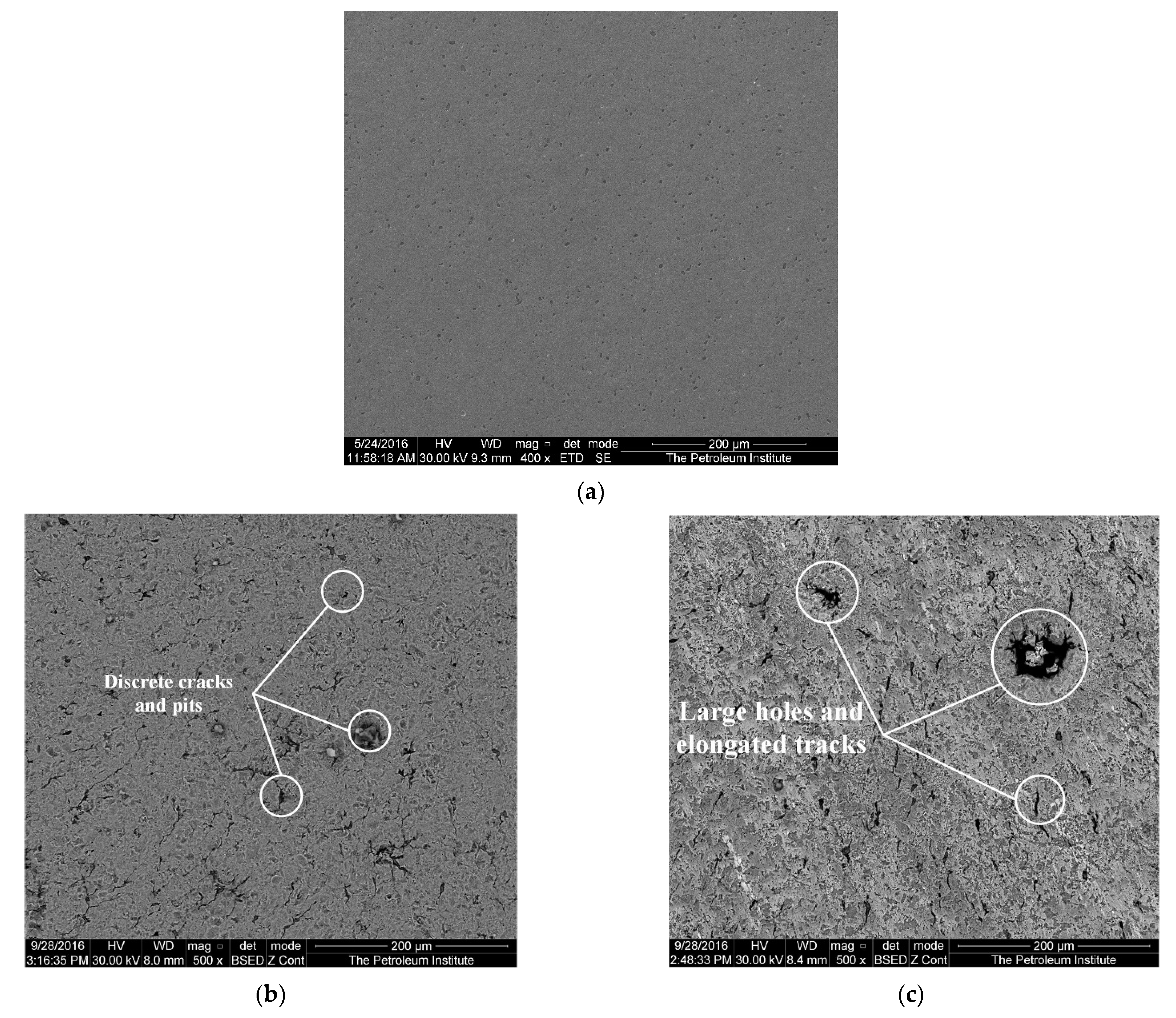
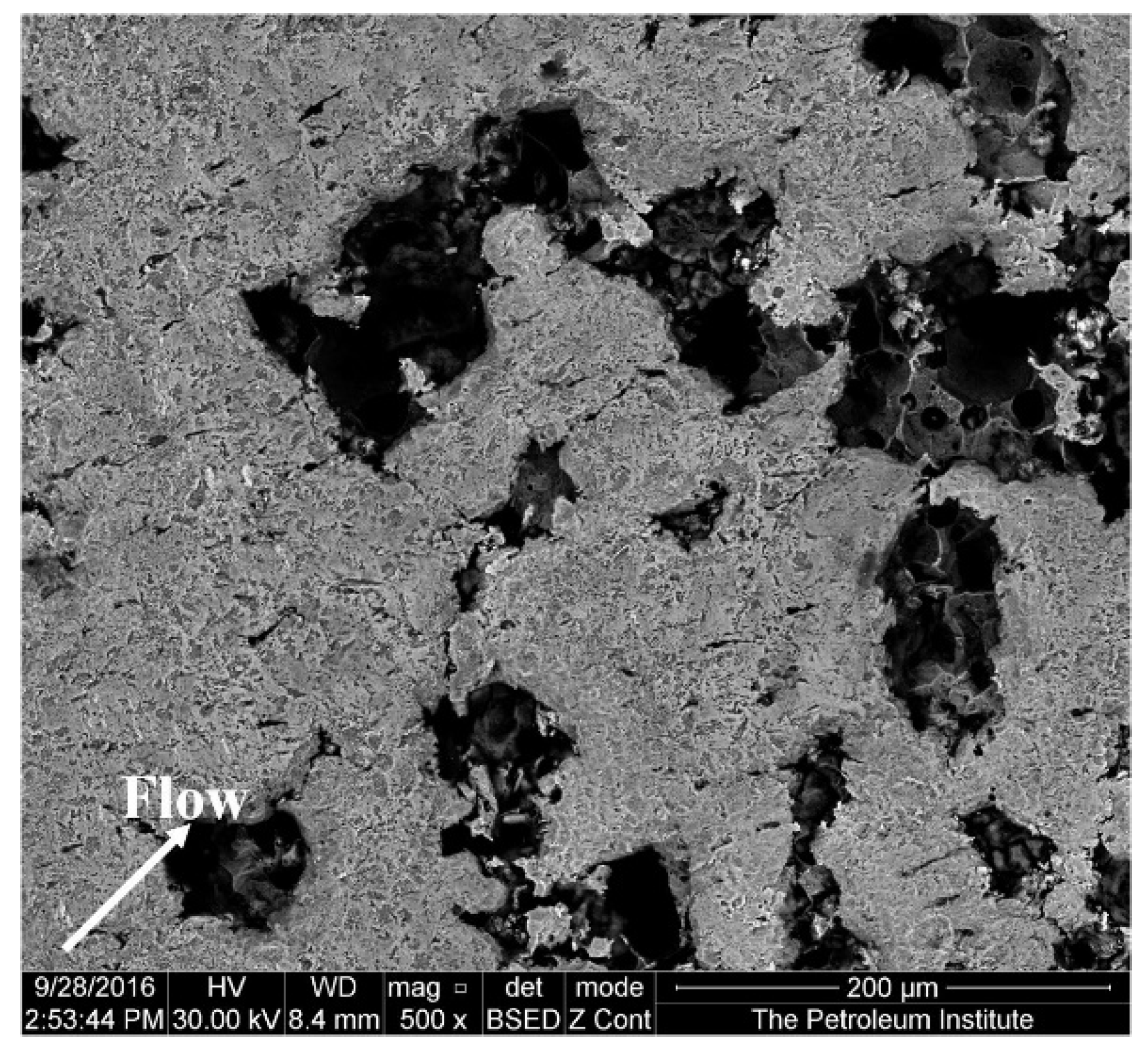
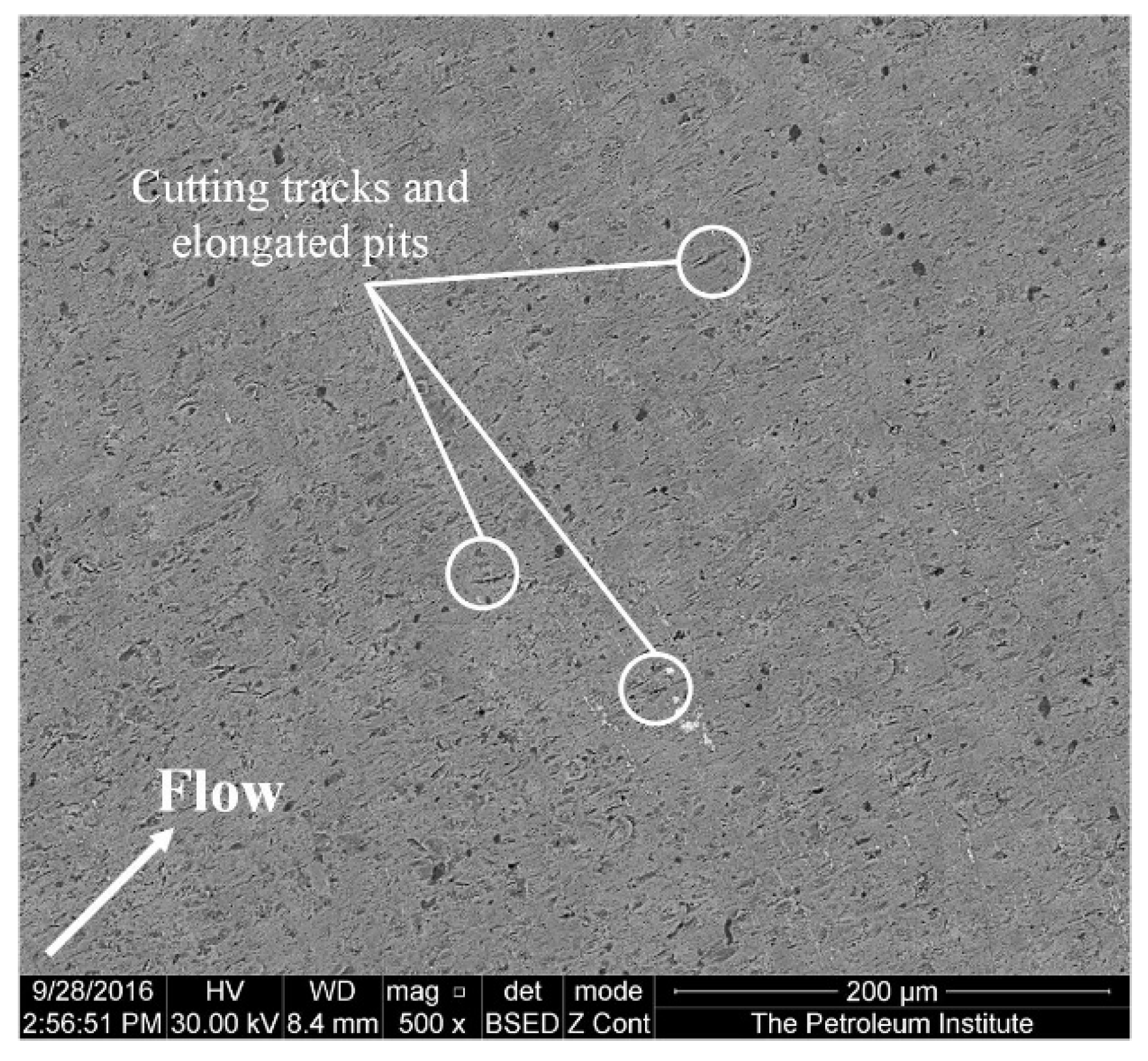
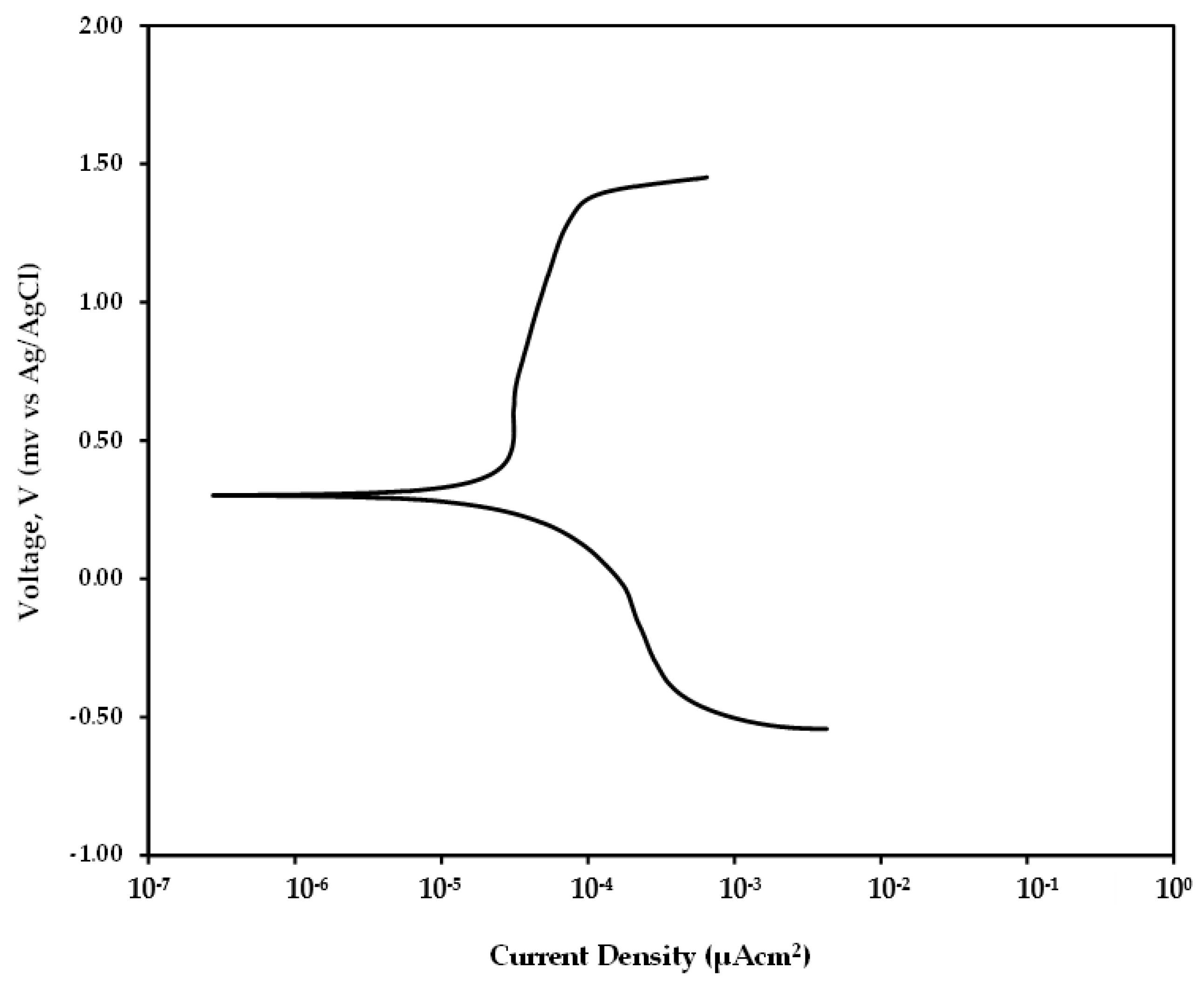
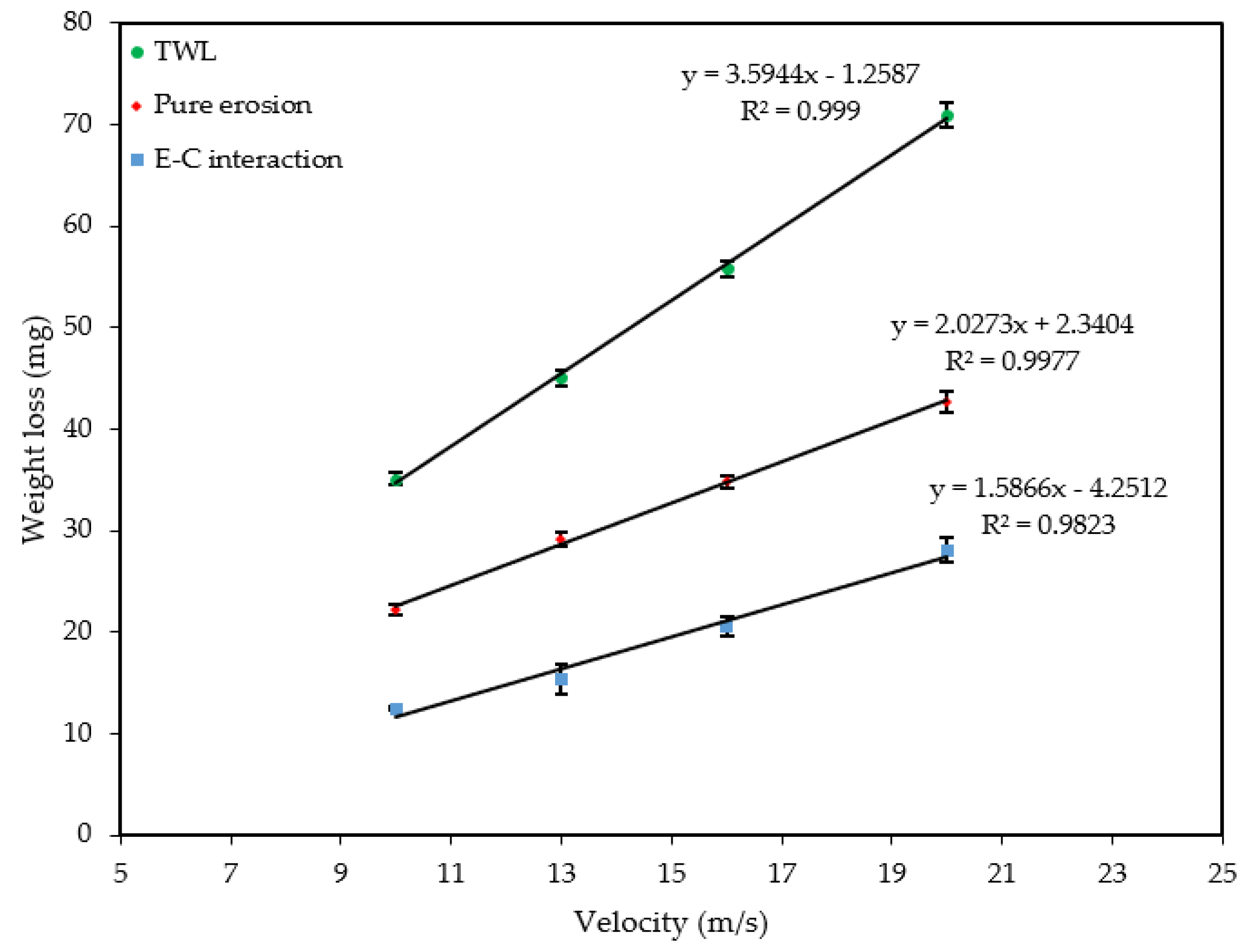
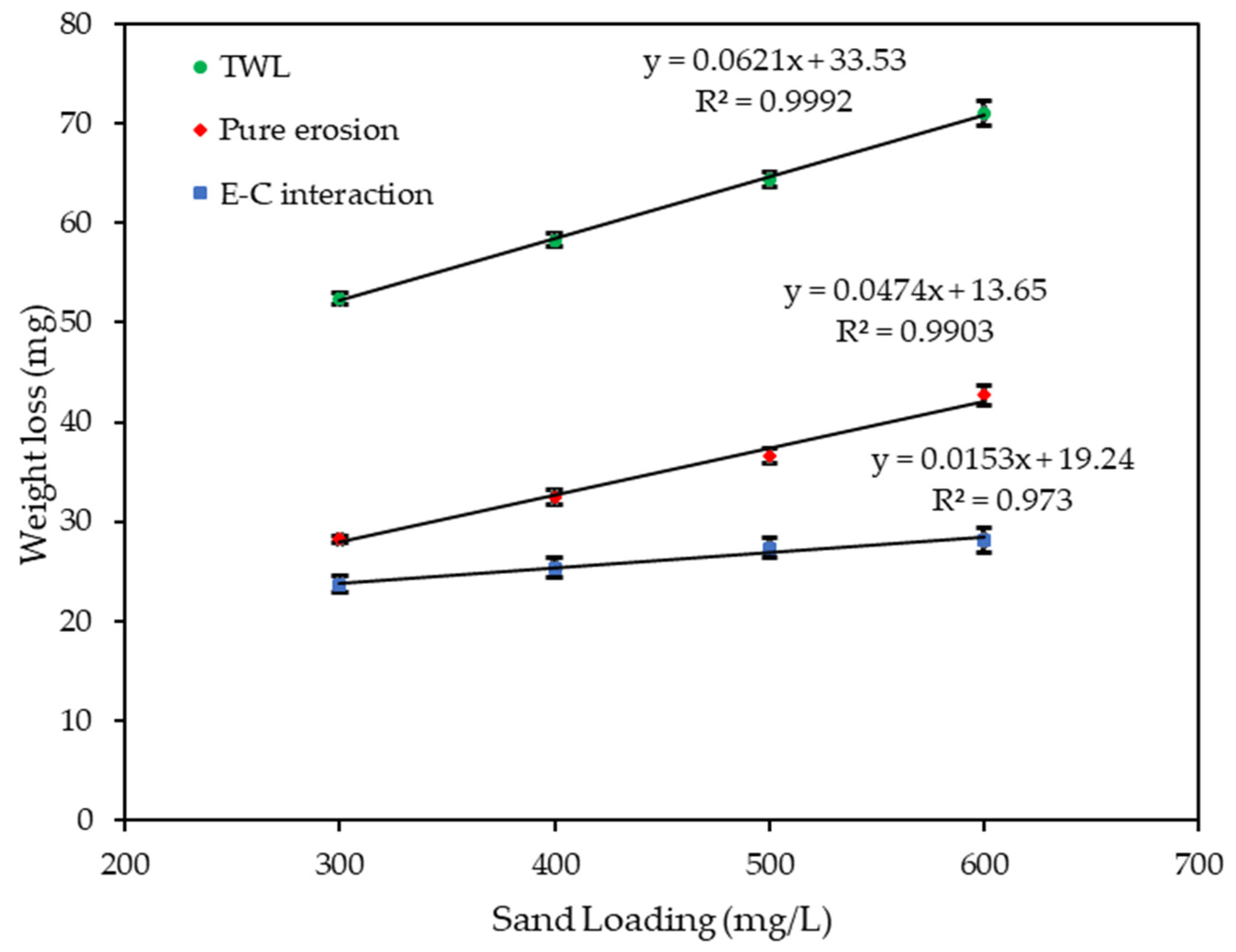
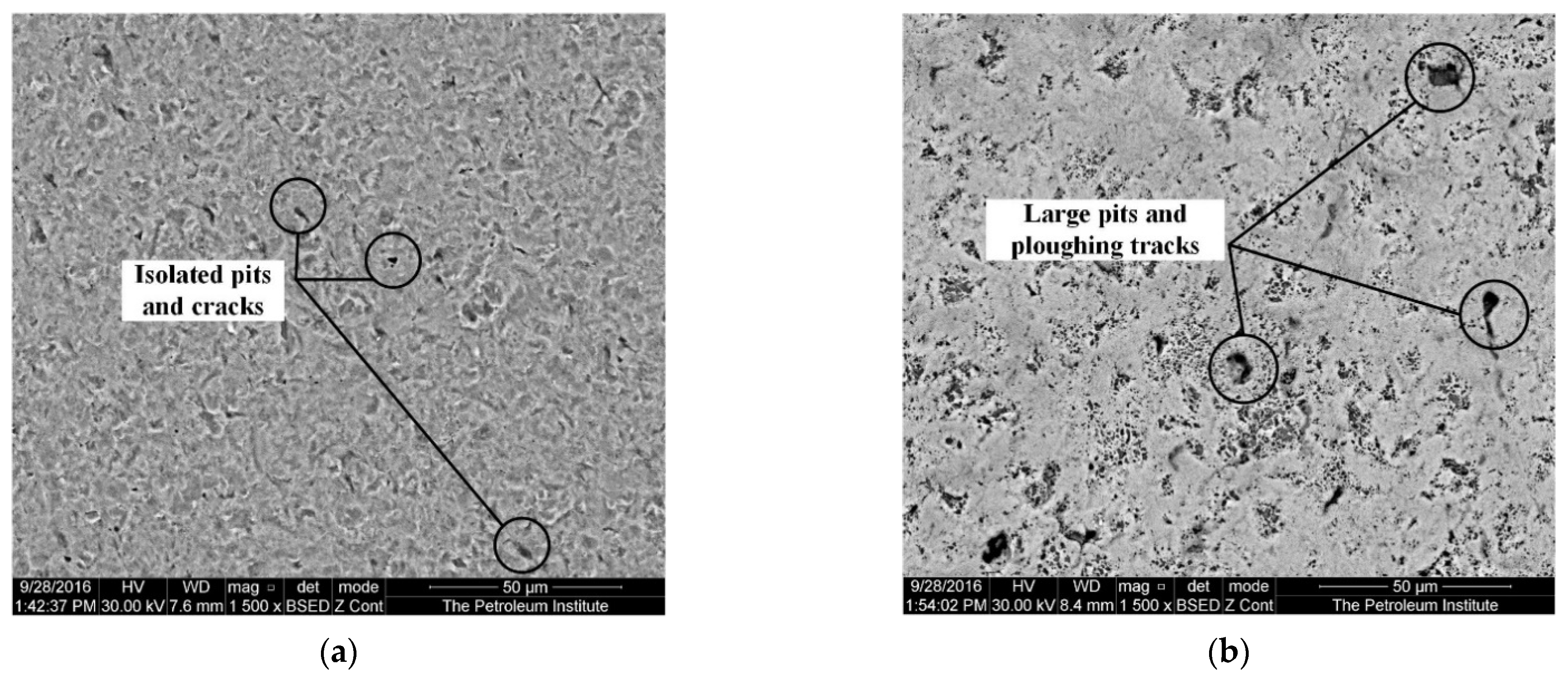
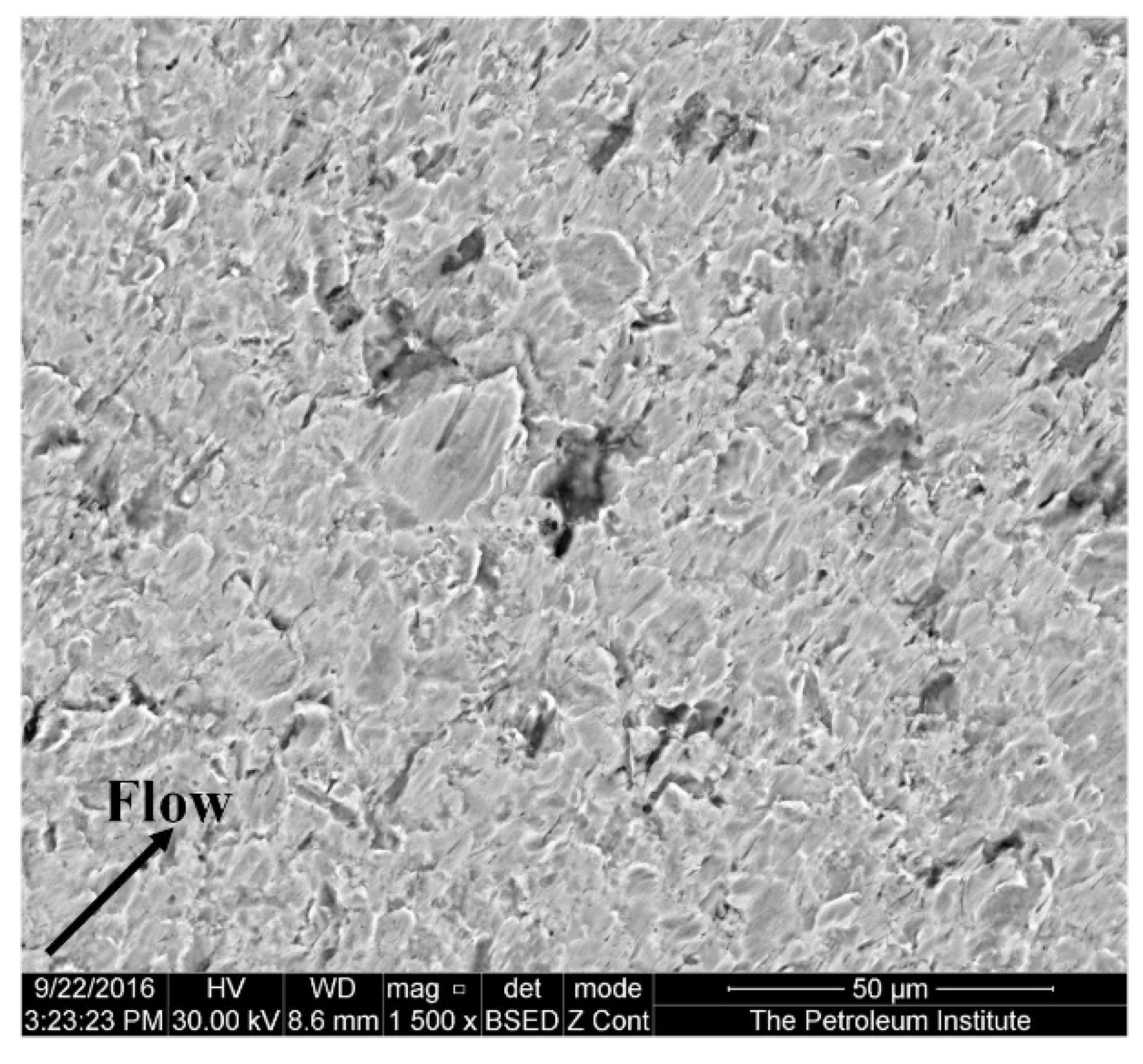
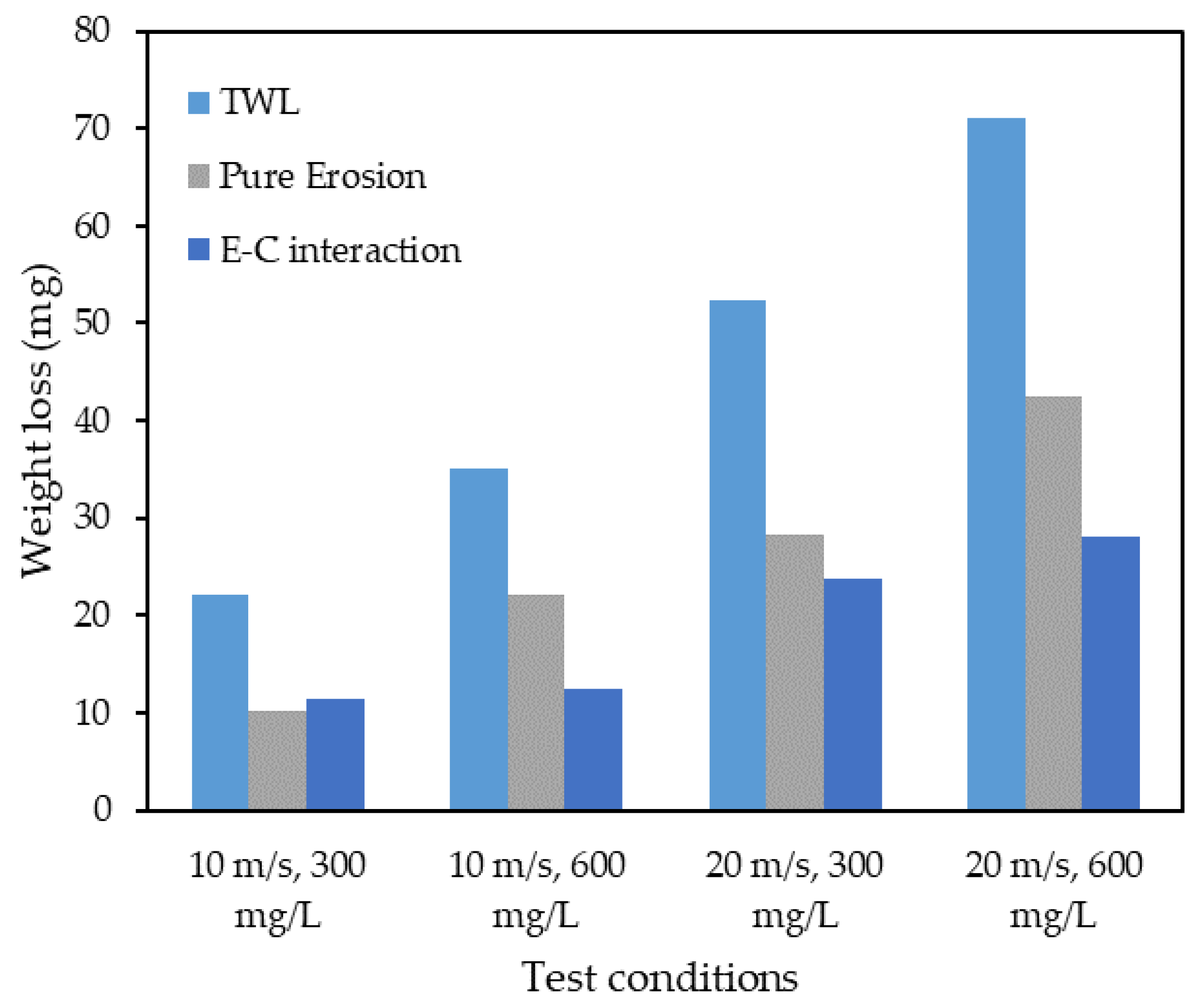
| Time (hours) | TWL (mg) | Error (mg) |
|---|---|---|
| 1 | 22.2 | ±0.46 |
| 2 | 38.8 | ±0.75 |
| 3 | 55.8 | ±0.79 |
| 4 | 71 | ±1.17 |
| Velocity (m/s) | Pure Erosion | E–C Interaction | ||||
|---|---|---|---|---|---|---|
(mg) | Error (mg) | Weight Loss (mg) | Error (mg) | Weight Loss (mg) | Error (mg) | |
| 10 | 35.13 | ±0.66 | 22.20 | ±0.54 | 12.52 | ±0.12 |
| 13 | 45.07 | ±0.81 | 29.23 | ±0.70 | 15.42 | ±1.45 |
| 16 | 55.83 | ±0.80 | 34.87 | ±0.61 | 20.55 | ±0.95 |
| 20 | 71 | ±1.17 | 42.67 | ±1.02 | 28.12 | ±1.20 |
| Sand Loading (mg/L) | Pure Erosion | E–C Interaction | ||||
|---|---|---|---|---|---|---|
(mg) | Error (mg) | Weight Loss (mg) | Error (mg) | Weight Loss (mg) | Error (mg) | |
| 300 | 52.33 | ±0.61 | 28.23 | ±0.32 | 23.68 | ±0.85 |
| 400 | 58.23 | ±0.65 | 32.47 | ±0.80 | 25.35 | ±0.98 |
| 500 | 64.33 | ±0.70 | 36.57 | ±0.70 | 27.35 | ±0.98 |
| 600 | 71 | ±1.17 | 42.67 | ±1.02 | 28.12 | ±1.21 |
| Run | V | S |
|---|---|---|
| 1 | −1 | −1 |
| 2 | −1 | +1 |
| 3 | +1 | −1 |
| 4 | +1 | +1 |
| Factors | Levels Used | |
|---|---|---|
| Low (−1) | High (+1) | |
| Velocity (m/s) | 10 | 20 |
| Sand Loading (mg/L) | 300 | 600 |
| Term | Coefficient | p-Value a |
|---|---|---|
| Constant | −15.70 | <0.001 |
| Velocity V | 2.4700 | <0.001 |
| Sand Loading S | 0.02500 | <0.001 |
| V × S | 0.001856 | <0.001 |
| R-Sq = 99.95% | R-Sq (adj) = 99.93% |
| Term | Coefficient | p-Value a |
|---|---|---|
| Constant | −17.40 | <0.001 |
| Velocity V | 1.5667 | <0.001 |
| Sand Loading S | 0.03211 | <0.001 |
| V × S | 0.000778 | <0.001 |
| R-Sq = 99.91% | R-Sq (adj) = 99.88% |
Publisher’s Note: MDPI stays neutral with regard to jurisdictional claims in published maps and institutional affiliations. |
© 2022 by the authors. Licensee MDPI, Basel, Switzerland. This article is an open access article distributed under the terms and conditions of the Creative Commons Attribution (CC BY) license (https://creativecommons.org/licenses/by/4.0/).
Share and Cite
Parancheerivilakkathil, M.S.; Parapurath, S.; Ainane, S.; Yap, Y.F.; Rostron, P. Flow Velocity and Sand Loading Effect on Erosion–Corrosion during Liquid-Solid Impingement on Mild Steel. Appl. Sci. 2022, 12, 2530. https://doi.org/10.3390/app12052530
Parancheerivilakkathil MS, Parapurath S, Ainane S, Yap YF, Rostron P. Flow Velocity and Sand Loading Effect on Erosion–Corrosion during Liquid-Solid Impingement on Mild Steel. Applied Sciences. 2022; 12(5):2530. https://doi.org/10.3390/app12052530
Chicago/Turabian StyleParancheerivilakkathil, Muhammed S., Shahid Parapurath, Sami Ainane, Yit Fatt Yap, and Paul Rostron. 2022. "Flow Velocity and Sand Loading Effect on Erosion–Corrosion during Liquid-Solid Impingement on Mild Steel" Applied Sciences 12, no. 5: 2530. https://doi.org/10.3390/app12052530
APA StyleParancheerivilakkathil, M. S., Parapurath, S., Ainane, S., Yap, Y. F., & Rostron, P. (2022). Flow Velocity and Sand Loading Effect on Erosion–Corrosion during Liquid-Solid Impingement on Mild Steel. Applied Sciences, 12(5), 2530. https://doi.org/10.3390/app12052530







